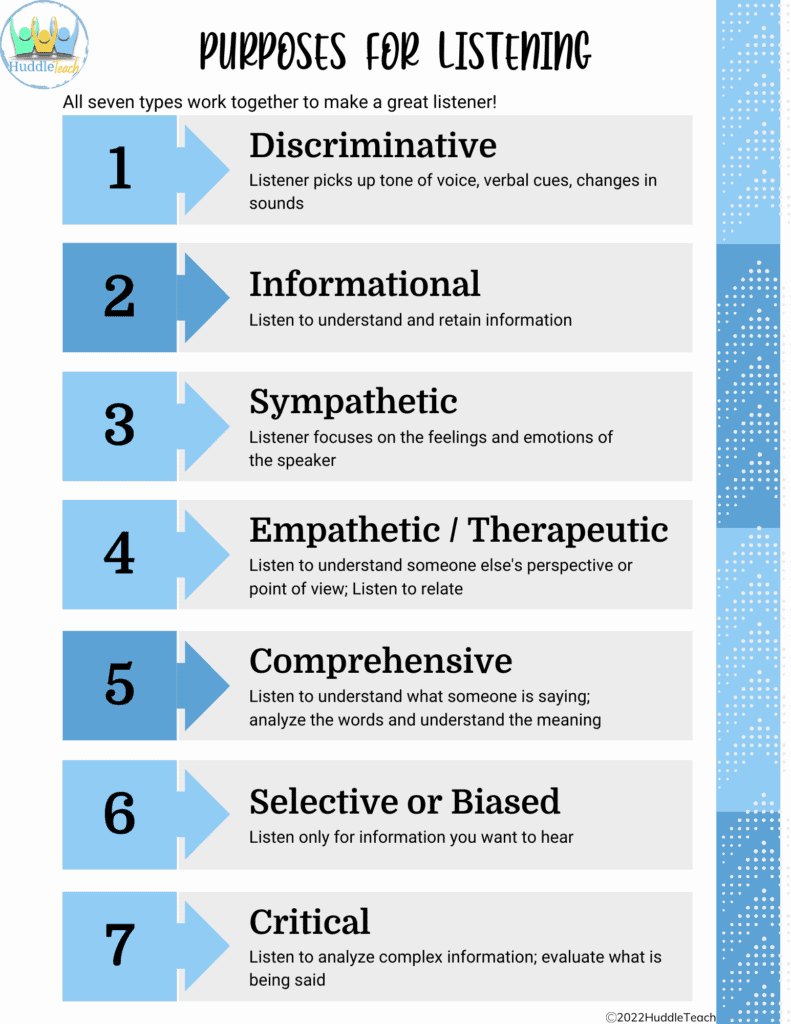The link that matters!

When we think of striving readers, we must expand our support to listening and reading comprehension.
Hit the Repeat button!
If you think your students aren’t listening to you, you’re probably right! Did you know that the human auditory brain structure is not fully mature until about 15 years old? That means those preteens (and many teens) don’t bring their complete neurological system to your classroom!
This became clear on the 300,000th repeated instructions about writing in complete sentences:
Me: Y’all! These sentence fragments are out of control!
7th graders: Huh?
Me: I asked you to write in complete sentences, and instead, all your answers are in fragments.
7th graders: So?
Me: SO, when the assignment calls for written answers, I expect you to write in complete sentences.
One Student: (in a confused tone, no sarcasm detected) Woah, wait! You said write (air quotes) incomplete sentences (air quotes). We did! Fragments are incomplete sentences, right?
Me: (blank stare – comes to a realization – head exploding emoji)
Me: Okay, from now on…when the assignment calls for written answers, I expect you to write USING COMPLETE SENTENCES.
And from that day on, I gave the instructions using the words USING COMPLETE SENTENCES. (And I only had to repeat those instructions 200,000 times.)
Listening and reading are both linguistic processes, but…
Listening obviously goes beyond hearing; it requires the brain to attend to complex auditory signals to create meaning. On a basic level, it is different from reading comprehension because a listener considers multi-dimensional information, such as intonation and speech patterns. Of course, voices produce more variations in meaning than what can be communicated by the two dimensional symbols of the alphabet. (Of course, specialized fonts help mitigate this difference!)
Like reading, though, the listener must evaluate the relationship between the form of the content and its meaning. In reading, the form of content, or format, can be anything from an academic essay to a poem. In listening, formats are classified more by purpose, such as informational or sympathetic.

While listening is a natural working of the brain, reading is not. Reading is acquired as part of a developmental process advanced by explicit instruction. Growth in reading comprehension depends on language knowledge, knowledge that is most often accrued through listening. In fact, listening comprehension levels typically indicate potential for reading comprehension.
Also, since listening and reading are both language functioning skills, they rely heavily on executive functioning skills, such as working memory. It is true that focus allows the intake of ideas (through eyes, ears, etc.) that leads to better recollection or memory of those ideas, which leads to learning. In other words, the more focus, the better listener and reader, and the better learner.
So how does listening influence reading comprehension?
Picture yourself in a large concert hall, but instead of performers playing Beethoven, the musicians simply hand out pages of written music. You may be able to identify the notes presented, a few chords maybe, or perhaps even read the music on the page. But if you have never heard Beethoven before, chances are, you’d have a difficult time replicating the nuances of the composition.
The same could be said about listening’s contribution to reading. Besides building background knowledge and vocabulary, students develop active listening skills, like noticing confusions. They also begin to understand the effects of prosody, intonation, and rate changes.
Most importantly, listening provides a voice for students who do not already hear one in their heads as they read. This model becomes the scaffold as students learn to substitute their own internal reading voice.
When students have a difficult time comprehending while reading silently, ask them to read aloud. When students are young, they use whisper phones, but older student’s cell phone microphone app works the same way! Now they are combining reading with the power of listening, and chances are, their comprehension of the text will increase!
Improve students’ listening skills
Students often have a difficult time hearing what we are trying to communicate – from the phoneme to the word to the sentence (and more!) levels. We can help by slowing our speech, annunciating, and providing visuals whenever possible. These help, too:
- Explicitly teach listening and its effect on learning. (Use linked lesson in whole or part, or as a template for a similar lesson. PREVIEW THE VIDEO referenced in the lesson for appropriateness for your students.)
- Use a rubric to help explain listening expectations.
- Incorporate listening games into your instruction. (More on this, below!)
- Read aloud to students or use audiobooks.
- Use podcasts, like these on Listenwise.com (create a free account!)
Listening comprehension games
We can also include games in our curriculum. There are many group games, like telephone and letter/word Bingo. (Google “group listening games for older kids” and you’ll get hundreds, like this one!), but here are some of our board game favorites. (Like all games, we suggest playing a test round and going through all materials before using the game with students to be sure they are appropriate for your situation.)
What is your favorite way to support listening comprehension skills with your students? We’d love to know!







